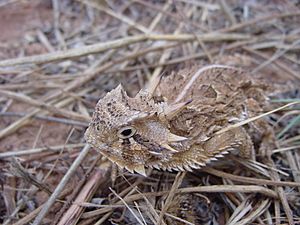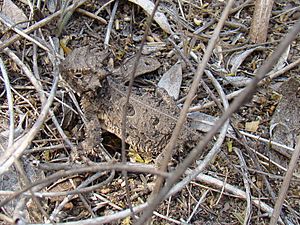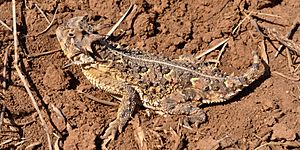Texas horned lizard facts for kids
Quick facts for kids Texas horned lizard |
|
|---|---|
 |
|
| Conservation status | |
| Scientific classification | |
| Genus: |
Phrynosoma
|
| Species: |
cornutum
|
| Synonyms | |
|
Agama cornuta Harlan, 1825 |
|
The Texas horned lizard (Phrynosoma cornutum) is a unique reptile with a spiky body. It is one of about 14 species of horned lizards found in North America. These lizards all belong to the group called Phrynosoma.
You can find the Texas horned lizard from Colorado and Kansas down to northern Mexico. It also lives from southeastern Arizona to Texas. Sometimes, you might see them in places like the Carolinas, Georgia, and Florida. These are usually lizards that were once pets and then released.
In the past, many Texas horned lizards lived in east Texas, Louisiana, and Arkansas. However, these were likely pets that either escaped or were set free. Today, while some groups are doing well, many populations in Texas and Oklahoma have greatly decreased. People sometimes confuse the Texas horned lizard with the Texas spiny lizard. This is because they look similar and live in the same areas.
Contents
What's in a Name?

Many people call the horned lizard a "horned toad" or "horned frog." But it's important to know that it is not a toad or a frog at all! It's a lizard. People use these names because of its round body and short snout. These features make it look a bit like a toad.
The scientific name Phrynosoma means "toad-bodied." The word cornutum means "horned." The "horns" on its head are actually part of its skull. They are made of real bone.
How Big Are They?
The Texas horned lizard is the largest of the horned lizard species. There are about 14 different kinds of horned lizards in the western United States and Mexico. This species is also found in the most places.
An average Texas horned lizard is about 69 mm (2.7 in) long from its snout to its tail base. Males can grow up to 94 mm (3.7 in) long. Females can be even bigger, reaching about 114 mm (4.5 in) in length.
Lizard Behavior and Habits
Even though they look fierce, Texas horned lizards are usually very calm. They love to sunbathe. They need bright sunlight to make vitamin D. Without enough sun, they can get sick. This is why you often see them on the sides of roads or in other open, rocky spots. They like to relax and soak up the sun.
At night, these lizards bury themselves in the sand to stay safe and warm. They prefer to move slowly. However, if they feel danger, they can move very fast! They will dart into thick grass or plants to escape. Horned lizards are also great at digging. They can quickly burrow underground to hide from threats. You can often find them near harvester ant hills. These ants are a big part of their diet.
Defense Strategies
The lizard's colors help it blend in with its surroundings. This is called camouflage. If a predator still finds it, the horned lizard has a special trick. It puffs up its body, making itself look very fat. This makes its body scales stick out, making it hard for a predator to swallow.
The Texas horned lizard has another amazing defense. It can squirt a stream of blood from the corners of its eyes! It can shoot this blood up to 5 ft (1.5 m) away. They do this by stopping blood flow from their head. This increases blood pressure and breaks tiny blood vessels around their eyelids. This surprises predators. Also, the blood has a bad taste for dog-like animals such as wolves, coyotes, and pet dogs. This defense usually works very well against these animals. However, it does not seem to bother predatory birds.
Why Are They Disappearing?
Harvester ants make up about 70% of the Texas horned lizard's diet. They also eat termites, beetles, and grasshoppers. In recent years, the number of these lizards has dropped by about 30% in their natural areas.
This decline is often blamed on a few things. One is the overuse of pesticides. These chemicals kill the harvester ant colonies that the lizards eat. Another problem is the spread of non-native, aggressive red imported fire ants. These fire ants also destroy harvester ant colonies. Without their main food source, the lizards struggle to survive.
Pet dogs and cats can also hunt and kill horned lizards. Because of these problems, the Texas horned lizard is now a protected species. In Texas, it is against the law to catch, own, move, or sell them without a special permit.
Even with laws to protect them, horned lizard populations are still disappearing in many areas. In 2014, a group asked the Oklahoma Department of Wildlife Conservation to list the Texas horned lizard as an endangered species in Oklahoma. They also mentioned that reptiles are dying off much faster than before, mostly because of human actions.
In Texas, the lizard is considered threatened. The Fort Worth Zoo has started a program to breed and reintroduce them into the wild. They raise baby lizards and release them. They hope that if they release many, enough will survive to help the wild population grow. In these types of programs, usually less than one percent of a female's offspring will live to become adults in the wild.
Studying the Lizards
Scientists at Texas Christian University, the Fort Worth Zoo, and Dallas Zoo are studying horned lizards. They collect information and do fieldwork. Since 2010, the Dallas Zoo has been doing a "mark-and-recapture" study. They catch lizards, tag them, collect data, and then release them. This helps them learn about the lizards' lives, how many live in an area, and what conditions are best for this threatened species. Money from special "Keep Texas Wild" license plates helps fund this research.
The Dallas Zoo and Houston Zoo are also working to create a group of lizards that can live and reproduce in zoos. They had some success with breeding in 2015.
Unique Lizard Families
Research for protecting these lizards has shown that Texas horned lizards have a lot of genetic diversity. This means there are different "families" or subspecies of lizards found in different parts of Texas. Even though these subspecies look the same, they are likely specially adapted to their local area. This makes it hard to know if a lizard from one area would survive if moved to a new place.
The most common type of Texas horned lizard lives in the Panhandle region of Texas. Other distinct subspecies have been found in East Texas, the Hill Country, and along the coast. Scientists don't know if these different subspecies can reproduce with each other over a long time. This makes it even more important to protect all of them. It's also unknown if any of these subspecies might be more resistant to the pesticides and fire ants that threaten them.
In Native American Culture
Some Native American people believe horned lizards are sacred. The animal is often seen in Native American art in the Southwestern United States and Mexico.
See also
 In Spanish: Lagarto cornudo para niños
In Spanish: Lagarto cornudo para niños





